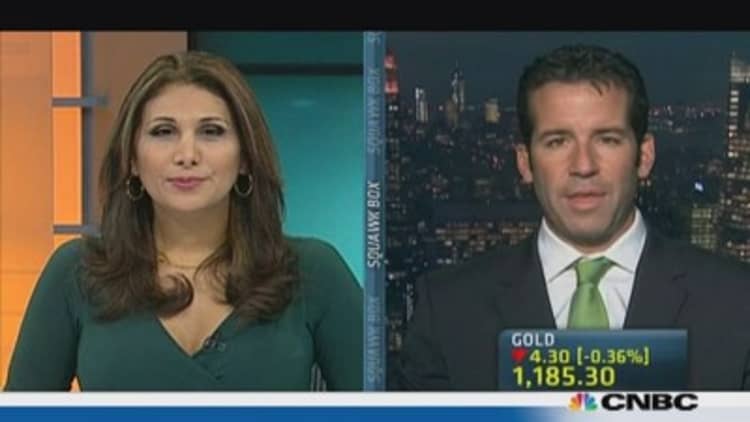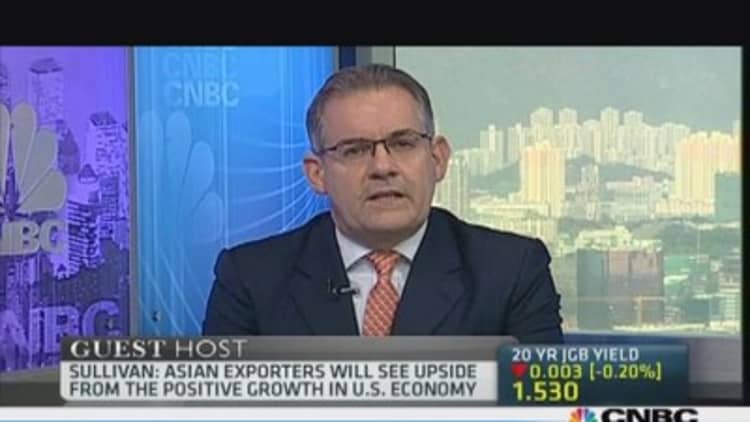China's benchmark money market rate climbed to a six-month high on Friday despite attempts by the central bank to calm sentiment, showing signs of a scramble for cash reminiscent of a massive crunch that occurred in June.
The volume-weighted average price of the benchmark seven-day bond repurchase rate - considered the most representative indicator of market liquidity conditions - rose to 8.1277 percent on Friday morning, its highest level since June 21.
(Read more: Marching higher once more: China cash rates)
The third day of sharp rises highlights the difficulty regulators are having gradually raising the cost of short-term credit to rein in speculative forms of finance without setting off destabilizing spikes that infect adjacent markets.
It also comes just as the U.S. Federal Reserve begins to wind down its aggressive easy-money strategy that helped fuel growth in emerging markets, raising concern about an impact on economic sentiment in the world's second-biggest economy.
The People's Bank of China said on Thursday afternoon that it would provide liquidity support to the market through short-term liquidity operations, in which the bank buys securities from banks behind closed doors in return for cash. It said it had already conducted one SLO, without specifying when, with whom, or how much.
China Business News, a newspaper owned by the Shanghai municipal government, reported on Friday morning that the bank had injected 200 billion yuan ($33 billion) through SLOs with selected banks, quoting an unnamed banking source.
But the PBOC assurance was clearly insufficient to calm markets, where rumours are beginning to swirl of loan defaults by commercial banks. The anxiety infected the stock market on Friday, with the CSI300 Index, which tracks the largest listed firms in Shanghai and Shenzhen, briefly falling more than 1 percent to a five-week low.
(Read more: China cash rates jump on liquidity worries)
"Even after last night the PBOC announced the short-term liquidity operation, there is still a concern in the short term because if the markets don't hear guidelines from the PBOC officials, banks are still in the tight mode in China," said Jackson Wong, Tanrich Securities' vice president for equity sales in Hong Kong.
"There is no positive catalyst and there are liquidity problems ... If it drops further, there might be some voices to ask for help from the central bank to roll out some policies to stablize the A-shares market."
Knock-on effects
Economists said it was unlikely that the latest crunch would create the same level of pressure banks faced in June, when the benchmark interbank rate peaked at 11.62 percent on June 20, but the situation has yet to stabilize and the root of the problem remains unclear.
(Read more: China's shares may be cheap, but they could get cheaper)

The June cash crunch was widely perceived to have been a swipe at risky shadow banking activities, but economists said November data showed that the riskier forms of shadow banking appeared to be under control.
At the same time, Chinese money markets are not supposed to be tight on liquidity given signs of strengthening hot money inflows chasing a rising yuan, but traders say sentiment still extremely cautious.
"It seems that the central bank thought the large treasury funds injection from the Ministry of Finance in the second half of December would significantly relax the market liquidity," wrote Liu Ligang and Zhou Hao of ANZ Bank in a research note, adding that the bank needs to rethink its year-end liquidity management strategy in light of recent events.
To some extent, the fire the PBOC is fighting is the result of its own efforts to crack down on speculative forms of financing that use the interbank market to fund speculative lending that has fuelled a property and investment bubble.
(Read more: China faces off with markets as money rates soar)
Chinese regulators are moving to raise the cost of credit as they try to encourage the companies and banks to borrow and invest more efficiently, as part of a wider scheme to restructure the economy away from its credit-intensive model that the government admits is unsustainable.
But economists worry that the PBOC is clumsy when it comes to communicating its intentions, making for a volatile market ruled by guess and sentiment, with possible knock-on effects on the wider economy.

For example, China is preparing to relaunch initial public offerings next year, a key part of its strategy to wean companies off their over-dependence on bank loans. But that will prove difficult if the stock market continues to take regular hits from an unstable money market.
For signs of what the PBOC specifically plans for the market, regulators' preference for general statements committing to preserving stability are of little use to traders, who read the tea leaves cast by the central bank during its regularly scheduled open market operations.
Thus when the PBOC held off from injecting funds on Thursday, even after rates rose abruptly on Wednesday, it set of a market panic that it is still struggling to unwind.
(Read more: China money market rates spike, but don't panic)
"We believe the PBoC is faced with some serious challenges with rapid unfolding of bottom-up interest rate liberalization and is confused on whether to target volume or rates (prices) of liquidity," wrote Lu Ting, an economist at Bank of America Merrill Lynch.
"With its limited predictability of flows and its insensitivity to market reactions, the PBoC finds it much more likely than before to make operation mistakes."

